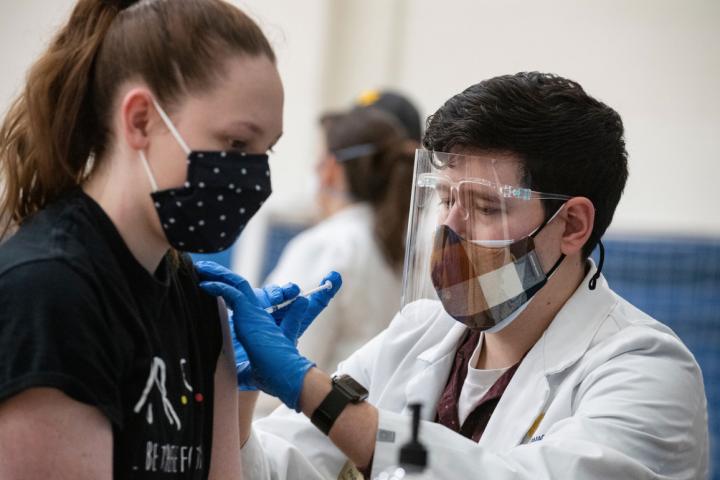
Credit: Brian Persinger/West Virginia University
As West Virginians receive the COVID-19 vaccine at record rates, citizens credit the power of medical science for making that shot in the arm possible.
But there’s a different kind of science that is driving a critical, yet less recognized role in the state’s vaccine rollout: data science.
For West Virginia University data scientists Brad Price and Katherine Kopp, who joined forces with Dariane Drake to form Data Driven WV in 2019, big data has shaped their careers in the John Chambers College of Business and Economics.
Now, it’s helping to shape the state in a transformative way as West Virginians count on COVID-19 vaccines to move the Mountain State past a pandemic.
Price and Kopp have implemented data science to support vaccine supply chain efforts by developing dashboards for the West Virginia Department of Health and Human Resources around populations in West Virginia, including how to identify those who are at-risk. This work was developed as an experiential learning project with five students from the M.S. in Business Data Analytics program.
Most notably, they have built a robust and agile digital inventory management system to track vaccine demand and inventory around the state.
“When we think about vaccines, most people don’t think about data,” said Price, assistant professor of Business Data Analytics in the Chambers College. “Before that shot goes in the arm, there has to be a plan to get it where it needs to go in the state. You have to set-up the whole supply chain and track where it is, where it’s going and understand how much you have and how much you need for it to be successful. Working without that piece would leave our state leadership operating blindfolded with vaccine distribution.”
The inventory management system Price and Kopp produced consists of eight web-based applications that manages demand from various entities, including county clinics, pharmacies, higher education and K-12. They match demand to the number of vials that are allocated.
The Centers for Disease Control and Prevention ships vials weekly, and the Data Driven WV team automates the process for recommending how many trays and boxes go to each of the five hubs in the state across five counties, including Kanawha, Monongalia, Cabell, Berkeley and Greenbrier. They then determine how many vials from the trays and boxes need to be transported to and from each hub to meet the demand. It also has checks and balances to determine how many vials have been distributed and how many are still on hand.
“There are eight applications running at any given time, and they’re all talking to each other,” Kopp said. “It’s an incredibly agile system running at a low cost, and as new vaccines come online like Johnson & Johnson, we have the ability to add them to the system and test in a day.”
It’s quite a leap from where it started. At its inception, it was a manual process with Google Docs and Microsoft Excel spreadsheets that has evolved into a complex inventory management system with automation.
When Price and Kopp were called into action by the DHHR and the West Virginia National Guard through Maj. Ryan Coss (who is also an adjunct lecturer in the Chambers College) in early 2021 to help with the vaccine rollout, they jumped in without hesitation – and they did it fast.
“In a normal software development process, what we did in a six-day period would probably take six weeks,” Kopp said. “By bringing in RStudio, our partners who provided the tool we used to build the application, utilizing students to turn it into an experiential learning opportunity and partnering with the state, we solved problems quickly.”
Price and Kopp have plenty of practice with moving fast to solve problems with data. It isn’t the first time the Data Driven WV duo has stepped up to help the state during COVID-19 through their work with the Joint Interagency Task Force.
Since the early days of the pandemic, they’ve been supporting PPE supply chain efforts by creating a forecasting model at the facility level for each hospital in the state. The model considers behaviors of West Virginians and how they migrate to healthcare in emergency situations; it was used to create a state stockpile to create backups for hospitals low on supplies. Reporting on these efforts is continuing, with weekly reports distributed each Thursday with the help of graduate assistant Ryan Midkiff.
Price, Kopp and Drake were recognized with a Civilian Service Achievement Award from the West Virginia National Guard during the summer of 2020 for their efforts.
According to retired Maj. Gen. (Ret.) James Hoyer, who continues to lead the Governor’s Joint Interagency Task Force in his new role at WVU, the Data Driven WV team has played an integral role in shaping the state’s perseverance through the pandemic.
“Preparation has been critical to protecting our citizens during COVID-19, and Data Driven WV has been the force behind the scenes that has allowed that preparation to happen at a very high level,” Hoyer said. “Their ability to use data to forecast PPE and track inventory for vaccines has allowed the state to be ready and nimble to shift with the unpredictable tides of the pandemic.”
While the accolades are appreciated, that’s not what fuels their team through the late nights of forecasting and building applications that has become commonplace over the last year.
It’s a bigger calling to serve West Virginia that keeps them going.
“It’s our job to fulfill our land-grant mission and protect the population of the state,” Price said. “If we can help West Virginia get to the other side of the pandemic, I’m all in. We’re not going to say ‘no’ to those calls.”
###
Media Contact
Heather Richardson
[email protected]
Original Source
https:/




